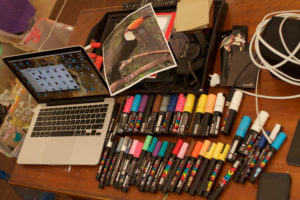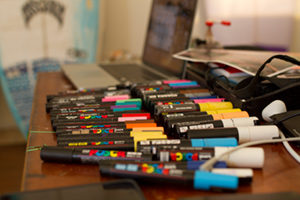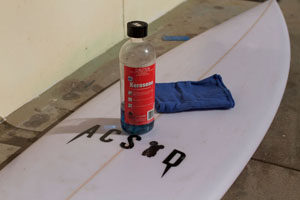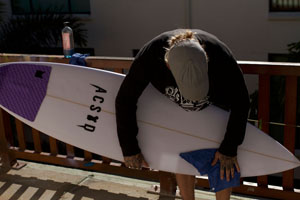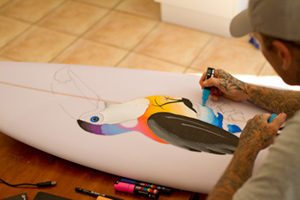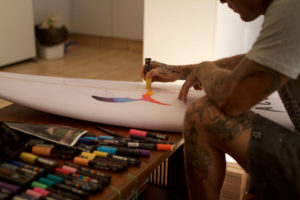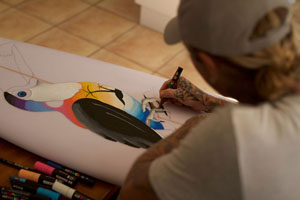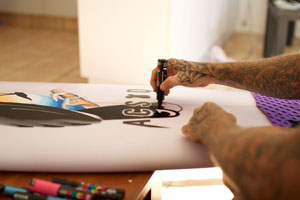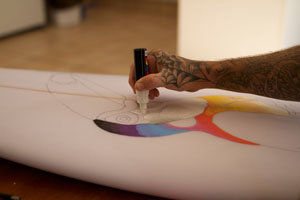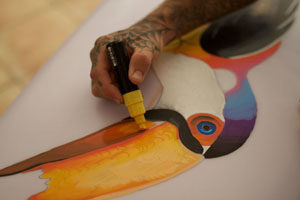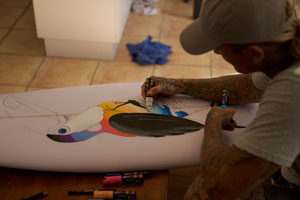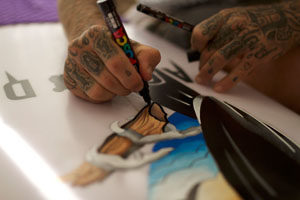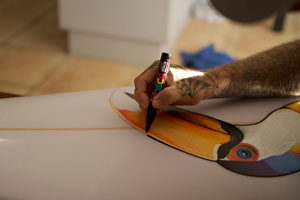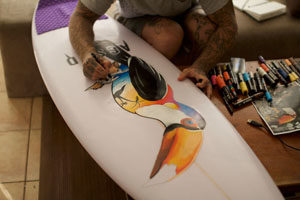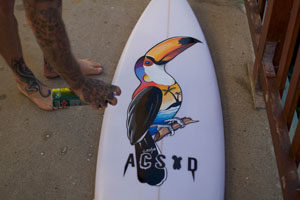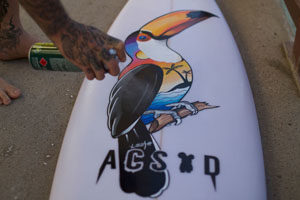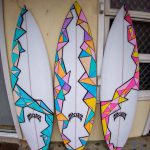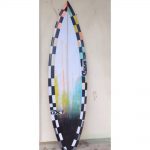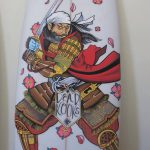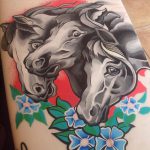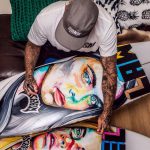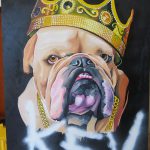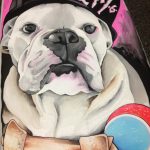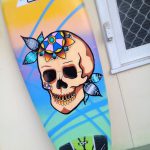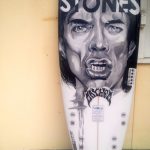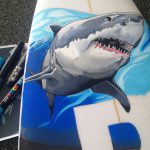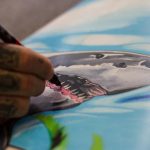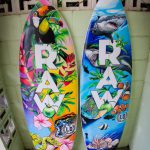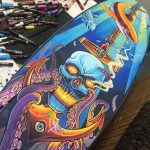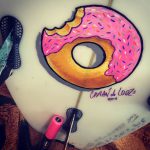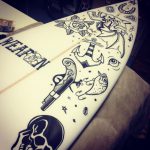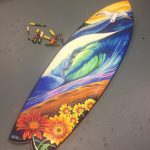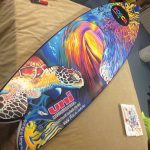- A Canvas – Surfboards/skateboards/bedroom walls/whatever you want. Posca pens work on pretty much everything! (for the purpose of this guide, we’ll be focusing on painting a surfboard)
- Posca Pens – Get them at your local Officeworks, leading newsagents and arts & crafts stores.
- Pencil and eraser to outline your artwork.
- Rag, kerosene or acetone, pillow or sheet.
- Scrap piece of paper to prime pens.
- Clean sheets of paper and or cotton glove (for smudges).

What Do I Need?
BE YOURSELF
Paint whatever you want! Whatever you think looks rad or inspires you, do that! Art’s personal, man. We’ve got an inspiration gallery of Posca artwork by Louis and Caspian de Looze that we think are awesome, have a look and make it your own. We hadn’t discussed what Louis was going to draw for this project and we said he could do what he felt would look cool. When we rocked up to his place, he had a printout of a Toucan and said, “I might draw a Toucan with a tropical sunset inside it.” Louis does what he wants, so you should too.
Know Your Tools: Posca Pen Range
Depending on what you want to draw, choose your paint pens accordingly. Posca has a range of seven tip sizes, including these below.
PC-1M (1mm)

The extra fine tip is ideal for fine detailing or lettering.
PC-3M (1.5mm)

Allows for accurate drawing or colouring while still fine enough to write or outline.
PC-5M (2.5mm)

Multi-purpose art creating machine. Comes in the largest colour range and is perfect for pretty much all applications, and its good the planet! Green-Net: manufactured from 47% recycled materials.
PC-8K (8mm)/PC-17K (15mm)


The big boys. Ideal for covering large areas like backgrounds without you having to colour vigorously for hours.
How Do I Prepare?
Work Area/Art Lab/Creation Station
This is a no mess no fuss way to customise your boards, so an all out art studio is definitely not necessary. Maybe lay a sheet on the floor incase you drop a pen and a pillow/mattress under your board if you’re going to be leaning/pressing it on the floor or a table.
Clean
If you’re getting creative on the deck of your board, it goes without saying to get rid of the wax first. We recommend using hot water or a hair dryer to melt the wax for easy removal, followed by a rub down with a rag dipped in kerosene or acetone. This ensures the paint goes onto a clean surface and can stick properly. Even if you’re doing the bottom of your board, give it a rub down with a clean rag and some kerosene or acetone, you’d be surprised what kind of dust and grime covers even the bottom of your board.
Sketch
Outline your artwork first with a pencil. Keep an eraser handy if you want, but this is just a rough sketch so there’s no need for precision just yet, the paint will cover the sketch completely. Step back every now and then for a different perspective to make sure your artwork and positioning is looking the way you want it.
Louis began the outline with a colouring in pencil, which snapped in about half a second. Without a sharpener or another pencil nearby, he went straight to Posca. When you’re as good as Louis is, I’m sure you can skip the pencil stage from time to time.
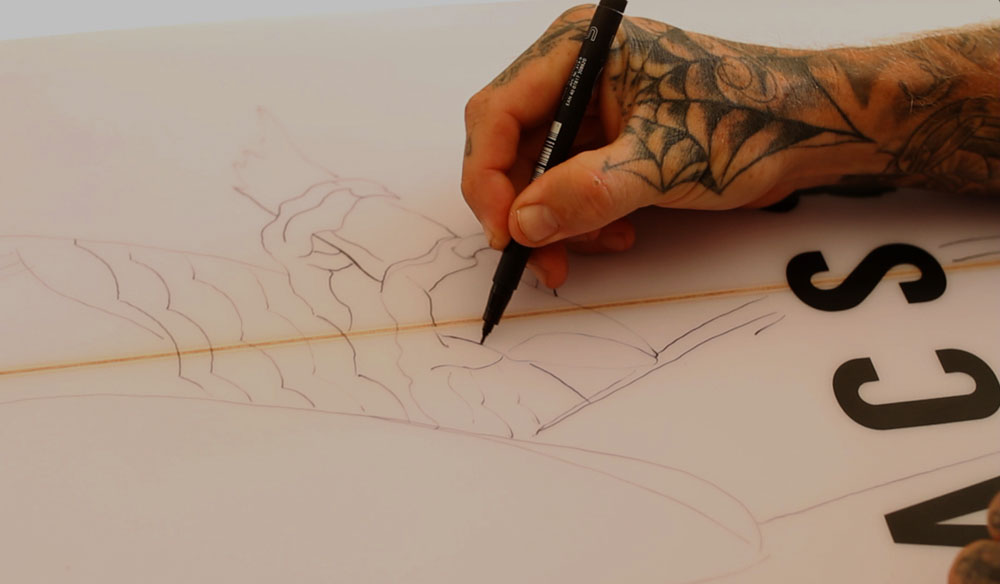
Prime Your Pens
Posca pens need to be ‘primed’ before use. Simply shake the marker vigorously with the cap securely attached in order to move the ball inside the barrel. On a test sheet, press the tip down several times to start the paint flowing. Replace the cap tightly after use.
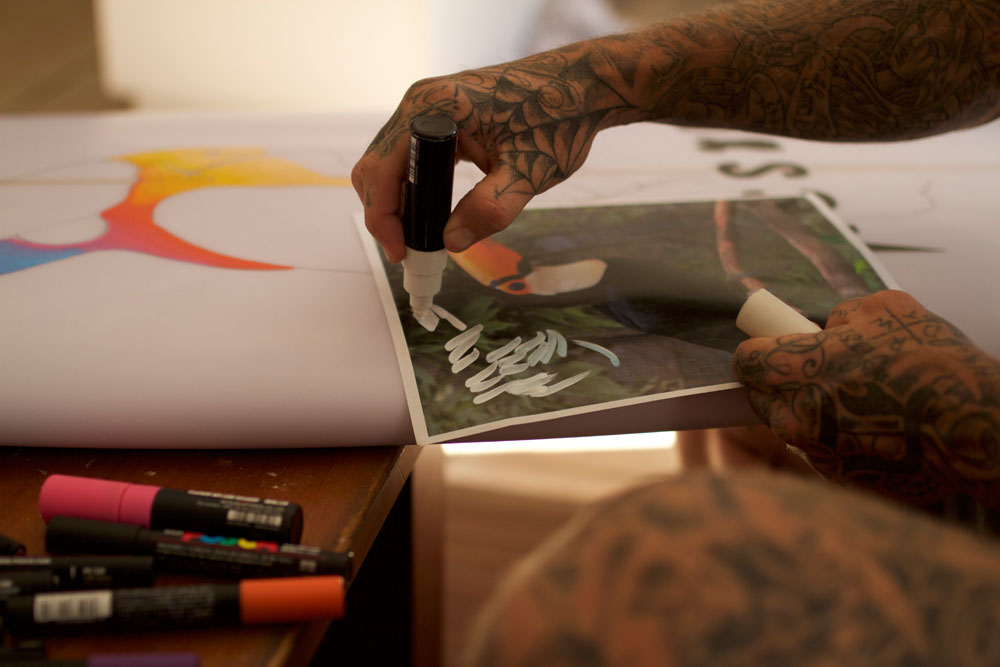
How Do I Get Started?
After priming your pens, you’re ready to get creating.
Colour
The colours you use are completely up to you! There are no rules in the world of Posca colours. The paint is dense and opaque so you can easily overlay lighter colours on top of darker colours.
Choosing Your Pens
Each Posca pen can be used for different applications, from colouring in large areas to fine detailed lines. See Louis using PC5-M and PC8-M for colouring larger areas and shading, he uses the PC3-M and PC1-M pens for finer details, sketching and outlines.
Louis’ Tips:
Anti Smudge – Keep your hand and arm elevated where possible to avoid touching the paint.
The paint dries relatively quickly which reduces smudging significantly, however it never hurts to be extra careful not to smudge your artwork! As you can see in Caspian’s video, he uses a combination of a sheet of paper and a cotton glove to reduce his skin coming into contact with the paint.
Blending Colours
You can blend colours from dark to light or light to dark, whichever you prefer or works best for your artwork. Louis blends from dark to light; black to purple, dark blue to white, brown to yellow and even black to white.
Louis’ Tip:
Louis blends his colours from dark to light and while their still wet, allowing for those smooth colour transitions in his artworks.
Outline
Finally, outline your artwork with black to make the image really pop out from the white background. This is a potential smudge danger zone, remember to keep your hand away from the rest of your art!
How Do I Finish?
Dry Time: Posca paint dries relatively quickly, a couple of minutes max (depending on how thick you’ve painted).
Seal: To ensure your art doesn’t rub off in the surf, a clear acrylic spray paint over the top is essential. Spray evenly over your artwork, allow it to dry for about 30 minutes and you’re good to go!
- White Knight Crystal Clear Acrylic Clear Gloss ($12.90 Bunnings)
- Dulux Duramax Gloss Clear Coat ($11.25 Bunnings)
Show Us Your Skills!
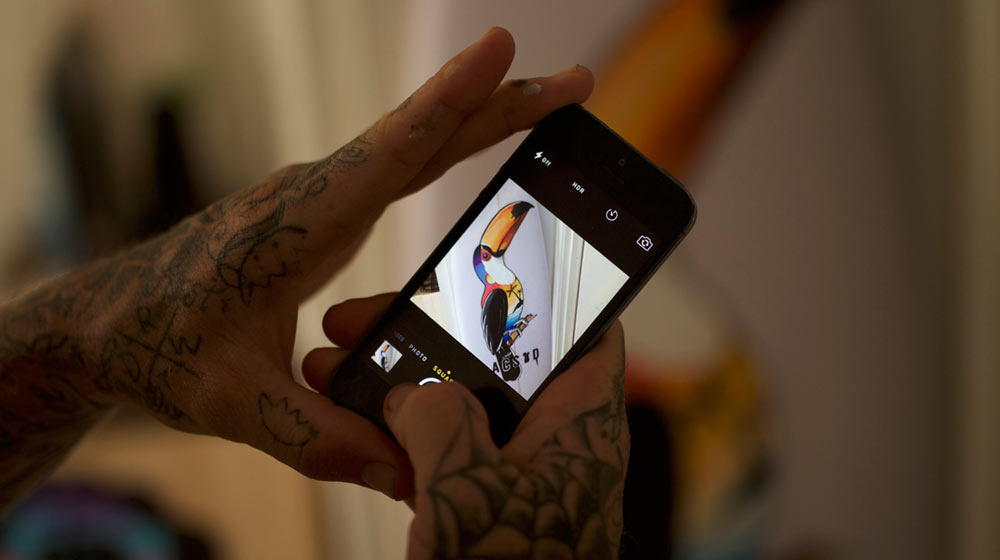
SURFBOARD SPECIFIC FAQs:
- What do I use to seal the paint?
Any acrylic clear coat spray.
White Knight Crystal Clear Acrylic Clear Gloss (we found it for $12.90 from Bunnings)
Dulux Duramax Gloss Clear Coat (we found it for $11.25 from Bunnings) - I’ve made a mistake, how do I fix it?
You’ve got some options depending on the mistake, if its early in the art work and you want to start over, simply wipe the paint off using the same kerosene or acetone you used to remove your wax. If it’s a small mistake, you can either wait for the paint to dry completely and paint over the top, or you can use some fine sand paper to sand down the paint and then paint over it to avoid an uneven build up of paint. - I’m finished and want to go surfing, do I just wax over the art?
Yes! The acrylic clear coat you’ve applied not only seals the paint but also protects it from waxing, sun and water damage. Wax away and go surf!



